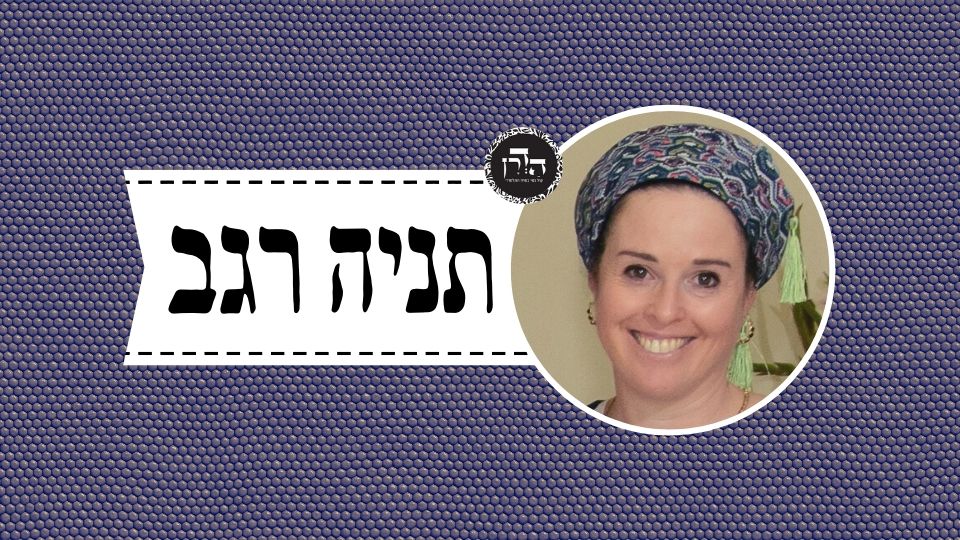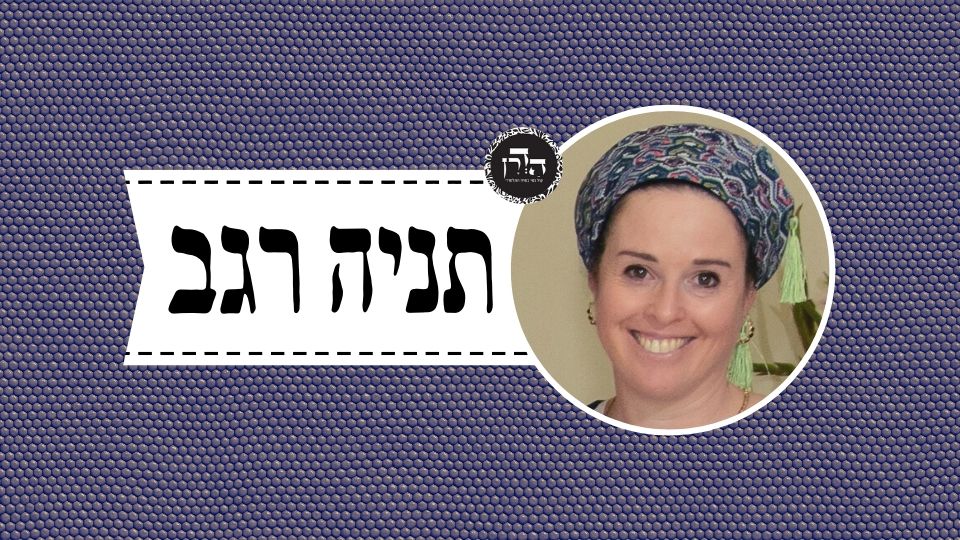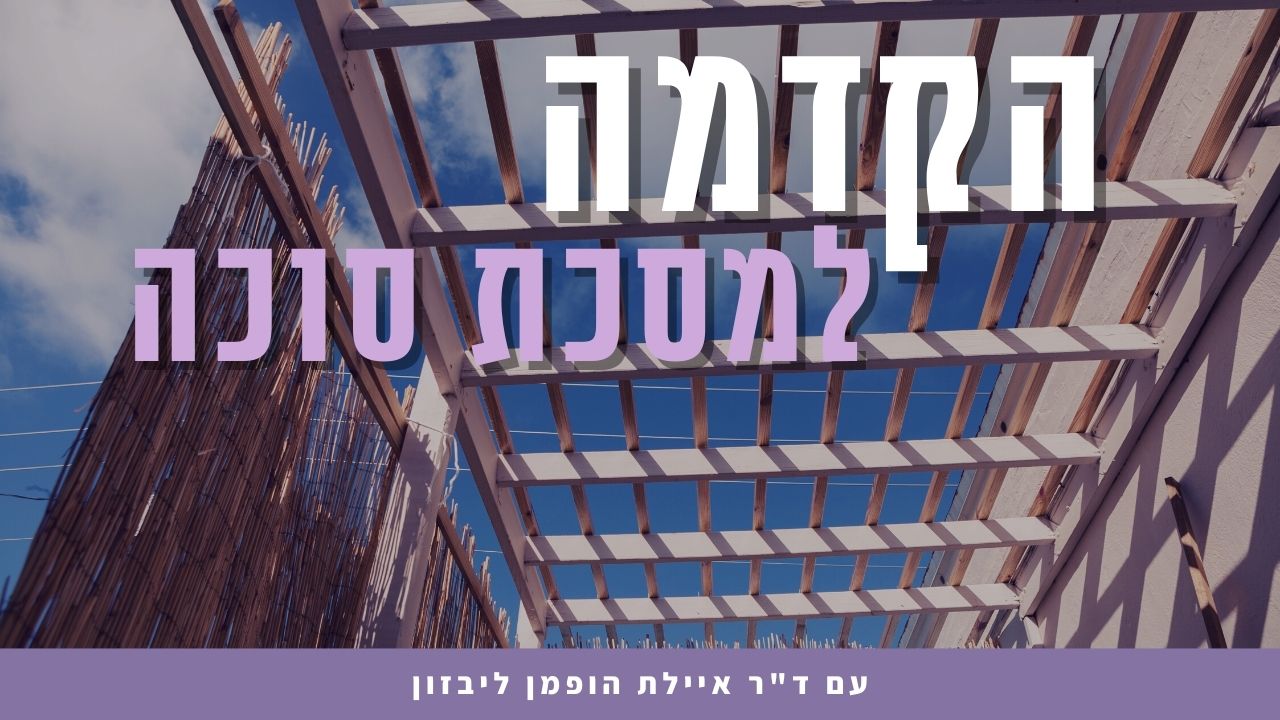סוכה יט
כִּי פְּלִיגִי אַלִּיבָּא דְּרַב. אַבָּיֵי כְּרַב, וְרָבָא אָמַר לָךְ: עַד כָּאן לָא אָמַר רַב הָתָם אֶלָּא דִּמְחִיצוֹת לְאַכְסַדְרָה הוּא דַּעֲבִידִי, אֲבָל הָכָא דְּלָאו לְהָכִי עֲבִידִי, לָא.
When they disagree is according to the opinion of Rav. Abaye holds in accordance with the opinion of Rav: The edge of the roof descends and seals both in the portico in the field and in the portico that one roofed as a sukka. And Rava could have said to you: Rav stated his opinion only there, with regard to a portico in the field, because the partitions formed by the descent of the edge of the roof are partitions established for the portico. However, here, in the case of a sukka, where the partitions formed by the descent of the edge of the roof are not partitions established for the portico, no, Rav would not say that the edge of the roof descends and seals.
תְּנַן: וְכֵן חָצֵר הַמּוּקֶּפֶת אַכְסַדְרָה. וְאַמַּאי? נֵימָא פִּי תִקְרָה יוֹרֵד וְסוֹתֵם!
The Gemara cites another proof. We learned in the mishna: With regard to a courtyard that is surrounded on three sides by a portico, if there are four cubits beneath the unfit roofing, the sukka is unfit. The Gemara asks: And why is the sukka unfit? Let us say that the edge of the roof descends and seals, forming a fit partition at the point where the roofing of the sukka begins?
תַּרְגְּמַהּ רָבָא אַלִּיבָּא דְּאַבָּיֵי: כְּשֶׁהִשְׁוָה אֶת קֵירוּיוֹ.
Rava interpreted the mishna in accordance with the opinion of Abaye: It is a case where one equalized the level of its roofing, i.e., the roofing of the sukka with the level of the roof of the portico. Since the edge of the roof of the portico is not visible inside the sukka, the principle: The edge of the roof descends and seals, does not apply.
בְּסוּרָא מַתְנִי לְהָא שְׁמַעְתָּא בְּהַאי לִישָּׁנָא. בְּפוּמְבְּדִיתָא מַתְנִי: סִיכֵּךְ עַל גַּבֵּי אַכְסַדְרָה שֶׁאֵין לָהּ פַּצִּימִין, דִּבְרֵי הַכֹּל פְּסוּלָה. יֵשׁ לָהּ פַּצִּימִין, אַבָּיֵי אָמַר: כְּשֵׁרָה, רָבָא אָמַר: פְּסוּלָה. אַבָּיֵי אָמַר כְּשֵׁרָה — אָמְרִינַן לָבוּד. רָבָא אָמַר פְּסוּלָה — לָא אָמְרִינַן לָבוּד. וְהִלְכְתָא כְּלִישָּׁנָא קַמָּא.
In Sura, they would teach this halakha in that language cited above. In Pumbedita they would teach it differently: If one roofed a portico that does not have posts on its open side, everyone agrees that the sukka is unfit. In the case of a portico that has posts less than three handbreadths apart on its open side, Abaye said: The sukka is fit, and Rava said: The sukka is unfit. Abaye said: The sukka is fit, as we say that the principle of lavud applies here; the posts are joined and form a partition for both the portico and the sukka in the courtyard outside the portico. Rava said: The sukka is unfit, as we do not say that the principle of lavud forms a partition for the sukka. The Gemara concludes: And the halakha is ruled in accordance with the first version.
רַב אָשֵׁי אַשְׁכְּחֵיהּ לְרַב כָּהֲנָא דְּקָא מְסַכֵּךְ עַל גַּבֵּי אַכְסַדְרָה שֶׁאֵין לָהּ פַּצִּימִין. אֲמַר לֵיהּ: לָא סָבַר מָר הָא דְּאָמַר רָבָא: יֵשׁ לָהּ פַּצִּימִין כְּשֵׁרָה, אֵין לָהּ פַּצִּימִין פְּסוּלָה! אַחְוִי לֵיהּ, נִרְאֶה מִבִּפְנִים וְשָׁוֶה מִבַּחוּץ.
The Gemara relates: Rav Ashi found Rav Kahana, who was placing roofing for a sukka atop a portico that did not have posts. He said to him: Doesn’t the Master hold in accordance with that which Rava said: If it has posts, the sukka is fit; if it does not have posts it is unfit? How can you use this as a sukka? Rav Kahana showed him that in this sukka the disparity between the sukka and the portico was visible from the inside and even from the outside. From outside, the portico and the sukka appeared to be one continuous structure. However, from inside, one of the walls of the portico was visibly thicker than the wall of the sukka, and that one handbreadth thickness serves as the third wall of the sukka.
אִי נָמֵי, נִרְאֶה מִבַּחוּץ וְשָׁוֶה מִבִּפְנִים.
Alternatively, in this case that disparity was visible from the outside and even from the inside. The exterior walls of the portico and of the sukka were not even. From the outside, it was plainly discernible that they were two separate structures. However, from the inside the sukka appeared to be a direct extension of the portico with no post protruding. In both cases, the protruding segment serves as the third wall of the sukka, which measures one handbreadth, and the sukka is fit.
דְּאִתְּמַר: נִרְאֶה מִבַּחוּץ וְשָׁוֶה מִבִּפְנִים, נִידּוֹן מִשּׁוּם לֶחִי. וְלֶחִי הַיְינוּ פַּצִּימִין.
This distinction is as it was stated in the context of merging courtyards that open into an alleyway that is open on one side to allow carrying there on Shabbat, one must establish a side post on one side of its opening: Any object that protrudes and is visible from outside the alleyway but is even with the wall on the inside of the alleyway has legal status of a side post, since it can be discerned from the outside. And the provisions that apply to a side post in the case of merging of alleyways are the same as those that apply to posts in the case of sukka. Rav Kahana’s sukka was essentially a portico with a post, and was fit for use as a sukka.
תָּנָא: פְּסָל הַיּוֹצֵא מִן הַסּוּכָּה — נִידּוֹן כַּסּוּכָּה. מַאי פְּסָל הַיּוֹצֵא מִן הַסּוּכָּה? אָמַר עוּלָּא: קָנִים הַיּוֹצְאִים לַאֲחוֹרֵי סוּכָּה.
§ It was taught in the Tosefta: Fit roofing that consists of different kinds of agricultural waste products that extend from the sukka has the legal status like that of the sukka. The Gemara asks: What is the meaning of: Waste products that extend from the sukka? Ulla said: Branches that extend behind the sukka and are not limited to the area within the sukka walls.
וְהָא בָּעֵינַן שָׁלֹשׁ דְּפָנוֹת! בִּדְאִיכָּא. וְהָא בָּעֵינַן הֶכְשֵׁר סוּכָּה! בִּדְאִיכָּא. וְהָא בָּעֵינַן צִלָּתָהּ מְרוּבָּה מֵחַמָּתָהּ! בִּדְאִיכָּא.
The Gemara asks: But don’t we require three walls to render an area covered with roofing a fit sukka? The Gemara answers: It is referring to a case where there are three walls. The two side walls of the sukka do not end at the middle wall between them; rather, they too extend behind the sukka, forming a second sukka. The Gemara asks: But don’t we require seven by seven handbreadths as the minimum area for fitness of a sukka? The Gemara answers: It is referring to a case where there is the requisite minimum area. The Gemara asks: But don’t we require that its shade exceeds its sunlight? The Gemara answers: It is referring to a case where there is more shade than sunlight.
אִי הָכִי מַאי לְמֵימְרָא? מַהוּ דְּתֵימָא: הוֹאִיל וּלְגַוַּואי עֲבִידִי וּלְבָרַאי לָא עֲבִידִי — אֵימָא לָא, קָא מַשְׁמַע לַן.
After noting that the sukka has three walls, the requisite area, and sufficient shade, the Gemara asks: If so, what purpose is there to state this halakha? The fact that this sukka extends from another is not relevant. The Gemara answers: Nevertheless, there is a novel element in this halakha. Lest you say that since, as evidenced by the placement of the connecting middle wall, these walls were initially established for inside the original sukka but not for outside the original sukka; and therefore you say no, the middle wall cannot be considered a wall for the additional sukka, Ulla teaches us that the initial intention is not relevant.
רַבָּה וְרַב יוֹסֵף אָמְרִי תַּרְוַויְיהוּ: הָכָא בְּקָנִים הַיּוֹצְאִים לִפְנִים מִן הַסּוּכָּה, וּמָשְׁכָא וְאָזְלָא חֲדָא דּוֹפֶן בַּהֲדַיְיהוּ. מַהוּ דְּתֵימָא: הָא לֵית בַּהּ הֶכְשֵׁר סוּכָּה, קָא מַשְׁמַע לַן.
Rabba and Rav Yosef both say with regard to the case in the Tosefta: Here, it is referring to a case with branches that extend before the front entrance of the sukka, and one of the side walls extends together with the roofing. Lest you say that this extension does not have the minimum requisite size for the fitness of a sukka, in terms of its area and number of walls, therefore, Ulla teaches us that it is fit because it is considered an extension of the sukka.
רַבָּה בַּר בַּר חָנָה אָמַר רַבִּי יוֹחָנָן: לֹא נִצְרְכָה אֶלָּא לְסוּכָּה שֶׁרוּבָּהּ צִלָּתָהּ מְרוּבָּה מֵחַמָּתָהּ, וּמִעוּטָהּ חֲמָתָהּ מְרוּבָּה מְצִלָּתָהּ. מַהוּ דְּתֵימָא: תִּפְּסַל בְּהָךְ פּוּרְתָּא, קָא מַשְׁמַע לַן. וּמַאי יוֹצֵא — יוֹצֵא מֵהֶכְשֵׁר סוּכָּה.
Rabba bar bar Ḥana said that Rabbi Yoḥanan said: The Tosefta was needed only to teach the case of a sukka where in its majority its shade exceeds its sunlight, and in its minority its sunlight exceeds its shade. Lest you say that since the extension lacks this basic requirement of a sukka, it is treated as if it were not there at all, and consequently the entire sukka should be rendered unfit due to that little area, therefore, Ulla teaches us that the entire area is one fit sukka. The Gemara asks: According to that understanding of the Tosefta, what is the meaning of: Waste that extends from the sukka? It means that the roofing extends beyond the halakhic parameters for fitness of a sukka. It does not refer to a physical extension of the sukka.
רַבִּי אוֹשַׁעְיָא אָמַר: לֹא נִצְרְכָה אֶלָּא לִסְכָךְ פָּסוּל פָּחוֹת מִשְּׁלֹשָׁה, בְּסוּכָּה קְטַנָּה. וּמַאי ״יוֹצֵא״ — יוֹצֵא מִתּוֹרַת סוּכָּה.
Rabbi Oshaya said: This Tosefta was needed only to teach the case of unfit roofing that measures less than three handbreadths in a small sukka. And what is the meaning of: Waste that extends from the sukka? It means that the roofing extends beyond the halakhic status of a fit sukka; it is not referring to a physical extension of the sukka. Nevertheless, it does not render the entire sukka unfit.
מַתְקֵיף לַהּ רַב הוֹשַׁעְיָא: לֹא יְהֵא אֶלָּא אֲוִיר, וַאֲוִיר פָּחוֹת מִשְּׁלֹשָׁה טְפָחִים בְּסוּכָּה קְטַנָּה מִי פָּסֵיל?
Rav Hoshaya strongly objects to this: What is the novel element in this Tosefta? Let the status of unfit roofing be only as strict as the status of empty space. And does space measuring less than three handbreadths in a small sukka render the entire sukka unfit? If less than three handbreadths of space, which has a stringent measure for rendering the sukka unfit, does not render the sukka unfit, clearly the same measure of unfit roofing does not render the sukka unfit.
אֲמַר לֵיהּ רַבִּי אַבָּא: זֶה מִצְטָרֵף וִישֵׁנִים תַּחְתָּיו, וְזֶה מִצְטָרֵף וְאֵין יְשֵׁנִים תַּחְתָּיו.
Rabbi Abba said to him: There is a distinction between unfit roofing and empty space. This unfit roofing combines with the fit roofing to compose the requisite measure. And one may even sleep beneath it, since the unfit roofing is nullified by the majority of fit roofing and completely incorporated into it. However, that space, although it too combines with the fit roofing to comprise the requisite measure of the sukka, one may not sleep beneath it, as it is not transformed into fit roofing. Therefore, there is a novel element in the explanation of Rabbi Hoshaya as well.
וּמִי אִיכָּא מִידֵּי דְּאִצְטְרוֹפֵי מִצְטָרֵף וְהוּא עַצְמוֹ אֵינוֹ כָּשֵׁר? אָמַר רַבִּי יִצְחָק בֶּן אֶלְיָשִׁב: אִין,
The Gemara questions this contention. Is there any item that combines with other items to engender fitness, but the item itself is not fit? Rabbi Yitzḥak ben Elyashiv said: Yes, that model exists in other areas of halakha as well.
טִיט הַנָּרוֹק יוֹכִיחַ, שֶׁמִּצְטָרֵף לְאַרְבָּעִים סְאָה, וְהַטּוֹבֵל בּוֹ — לֹא עָלְתָה לוֹ טְבִילָה.
The case of mortar that is liquid and can be poured proves that there are situations where items that themselves are unfit render other items fit, as, on the one hand, it combines with water to complete the requisite measure of forty se’a to render a ritual bath fit to purify. But, on the other hand, one who immerses in a bath filled only with mortar, the immersion does not fulfill his obligation.
מַתְנִי׳ הָעוֹשֶׂה סוּכָּתוֹ כְּמִין צְרִיף, אוֹ שֶׁסְּמָכָהּ לְכוֹתֶל — רַבִּי אֱלִיעֶזֶר פּוֹסֵל מִפְּנֵי שֶׁאֵין לָהּ גַּג, וַחֲכָמִים מַכְשִׁירִין.
MISHNA: One who establishes his sukka like a type of circular hut, with no roof whose walls slope down from the center or who rested the sukka against the wall, by taking long branches and placing one end on the ground and leaning the other end against the wall to establish a structure with no roof, Rabbi Eliezer deems it unfit because it does not have a roof, and the Rabbis deem it fit; as, in their opinion, the roof and the walls may be a single entity, indistinguishable from each other.
גְּמָ׳ תָּנָא: מוֹדֶה רַבִּי אֱלִיעֶזֶר שֶׁאִם הִגְבִּיהָהּ מִן הַקַּרְקַע טֶפַח, אוֹ שֶׁהִפְלִיגָהּ מִן הַכּוֹתֶל טֶפַח — שֶׁהִיא כְּשֵׁרָה.
GEMARA: It was taught in a baraita: Rabbi Eliezer concedes that if one lifted one of these types of sukkot off the ground at least one handbreadth, thereby creating a vertical wall, or if one distanced the sukka resting against the wall one handbreadth from the wall, the sukka is fit. In these cases, the difference between the wall and the roof is conspicuous.
מַאי טַעְמַיְיהוּ דְּרַבָּנַן? שִׁיפּוּעֵי אֹהָלִים כְּאֹהָלִים דָּמוּ.
The Gemara asks: What is the rationale for the opinion of the Rabbis, who deem a sukka fit even where it is an inclined roof rather than a flat one? The Gemara answers: In their opinion, the legal status of the incline of a tent is like that of a tent. As long as it provides shelter, there is no need for a distinct, conspicuous roof for it to be a fit sukka.
אַבָּיֵי אַשְׁכְּחֵיהּ לְרַב יוֹסֵף דְּקָא גָּנֵי בְּכִילַּת חֲתָנִים בַּסּוּכָּה. אֲמַר לֵיהּ: כְּמַאן — כְּרַבִּי אֱלִיעֶזֶר? שָׁבְקַתְּ רַבָּנַן וְעָבְדַתְּ כְּרַבִּי אֱלִיעֶזֶר!
It is related: Abaye found Rav Yosef, his teacher, who was sleeping inside a netted bridal canopy, whose netting inclines down, inside a sukka. Ostensibly, Rav Yosef did not fulfill his obligation, as he slept in the tent formed by the canopy and not directly in the sukka. Abaye said to him: In accordance with whose opinion do you hold, that you do not consider this netting a tent? Is it in accordance with the opinion of Rabbi Eliezer, who maintains that a structure without a distinct roof does not have the legal status of a tent, and therefore the netting does not constitute a barrier between the roofing of the sukka and the person sleeping below? Did you abandon the opinion of the Rabbis, who maintain that the netting constitutes a barrier because the legal status of a structure without a distinct roof is that of a tent, and act in accordance with the opinion of Rabbi Eliezer? In disputes between an individual Sage and multiple Sages, the halakha is in accordance with the multiple Sages, i.e., the Rabbis.
אֲמַר לֵיהּ, בָּרַיְיתָא אִיפְּכָא תָּנֵי: רַבִּי אֱלִיעֶזֶר מַכְשִׁיר וַחֲכָמִים פּוֹסְלִין. שָׁבְקַתְּ מַתְנִיתִין וְעָבְדַתְּ כְּבָרַיְיתָא?
Rav Yosef said to him: In the baraita, the opposite is taught. Rabbi Eliezer deems it fit and the Rabbis deem it unfit. Abaye asked him: Did you abandon the mishna, whose formulation is authoritative, and act in accordance with a baraita, which may not be accurate?
אֲמַר לֵיהּ: מַתְנִיתִין יְחִידָאָה הִיא. דְּתַנְיָא: הָעוֹשֶׂה סוּכָּתוֹ כְּמִין צְרִיף אוֹ שֶׁסְּמָכָהּ לְכוֹתֶל, רַבִּי נָתָן אוֹמֵר: רַבִּי אֱלִיעֶזֶר פּוֹסֵל מִפְּנֵי שֶׁאֵין לָהּ גַּג, וַחֲכָמִים מַכְשִׁירִין.
Rav Yosef said to him: I have proof that the formulation of this particular baraita is precise, as the formulation of the mishna is an individual version of the dispute, and most of the Sages adopt the version of the baraita, as it is taught in another baraita: One who establishes his sukka like a type of circular hut or rests the sukka against the wall, Rabbi Natan says that Rabbi Eliezer deems the structure unfit because it does not have a roof, and the Rabbis deem it fit. Apparently, the mishna reflects only Rabbi Natan’s version of the argument. According to most of the Sages, the correct formulation of the dispute is that of the baraita: Rabbi Eliezer deems it fit and the Rabbis deem it unfit. The halakha is in accordance with the latter version of the dispute, and therefore it is permitted to sleep inside a bridal canopy in a sukka.
מַתְנִי׳ מַחְצֶלֶת קָנִים גְּדוֹלָה, עֲשָׂאָהּ לִשְׁכִיבָה — מְקַבֶּלֶת טוּמְאָה, וְאֵין מְסַכְּכִין בָּהּ. לְסִיכּוּךְ — מְסַכְּכִין בָּהּ, וְאֵינָהּ מְקַבֶּלֶת טוּמְאָה. רַבִּי אֱלִיעֶזֶר אוֹמֵר: אַחַת קְטַנָּה וְאַחַת גְּדוֹלָה, עֲשָׂאָהּ לִשְׁכִיבָה — מְקַבֶּלֶת טוּמְאָה וְאֵין מְסַכְּכִין בָּהּ, לְסִיכּוּךְ — מְסַכְּכִין בָּהּ, וְאֵינָהּ מְקַבֶּלֶת טוּמְאָה.
MISHNA: In the case of a large mat of reeds, if one initially produced it for the purpose of lying upon it, it is susceptible to ritual impurity like any other vessel, and therefore one may not roof a sukka with it. If one initially produced it for roofing, one may roof a sukka with it, and it is not susceptible to ritual impurity, as its legal status is not that of a vessel. Rabbi Eliezer says that the distinction between mats is based on use, not size. Therefore, with regard to both a small mat and a large mat, if one produced it for the purpose of lying upon it, it is susceptible to ritual impurity and one may not roof a sukka with it. If one produced it for roofing, one may roof a sukka with it, and it is not susceptible to ritual impurity.
גְּמָ׳ הָא גּוּפַהּ קַשְׁיָא. אָמְרַתְּ: עֲשָׂאָהּ לִשְׁכִיבָה — מְקַבֶּלֶת טוּמְאָה וְאֵין מְסַכְּכִין בָּהּ. טַעְמָא דַּעֲשָׂאָהּ לִשְׁכִיבָה, הָא סְתָמָא — לְסִיכּוּךְ.
GEMARA: The Gemara analyzes the formulation of the mishna and raises a difficulty. This mishna itself is difficult, as it contains an apparent contradiction. On the one hand, you said: If one produced it for the purpose of lying upon it, it is susceptible to ritual impurity and one may not roof a sukka with it. The reason it is unfit for roofing is due to the fact that one produced it specifically for the purpose of lying upon it. Presumably, a mat produced without designation is for roofing, and therefore one may roof a sukka with it.
וַהֲדַר תָּנֵי: לְסִיכּוּךְ מְסַכְּכִין בָּהּ וְאֵינָהּ מְקַבֶּלֶת טוּמְאָה, טַעְמָא דַּעֲשָׂאָהּ לְסִיכּוּךְ, הָא סְתָמָא — לִשְׁכִיבָה!
And then it is taught in the mishna: If one produced it for roofing, one may roof a sukka with it, and it is not susceptible to ritual impurity. The reason it is fit roofing is due to the fact that one produced it specifically for roofing. This implies that a mat that one produced without designation is presumably for the purpose of lying upon it, and therefore one may not roof a sukka with it. The inferences drawn from these two clauses in the mishna about a mat produced without designation contradict each other.
הָא לָא קַשְׁיָא: כָּאן בִּגְדוֹלָה, כָּאן בִּקְטַנָּה.
The Gemara answers: This is not difficult. Here, in the first clause of the mishna, it is referring to a large mat, which is typically not produced for the purpose of lying upon it. Therefore, it is unfit for roofing only if it is produced specifically for the purpose of lying upon it. If it is produced without designation, it is presumably for roofing, and one may roof a sukka with it. There, in the second clause of the mishna, it is referring to a small mat, which is typically not produced for roofing. Therefore, one may roof a sukka with it only if it is produced specifically for roofing. If it is produced without designation, it is presumably for the purpose of lying upon it, and one may not roof a sukka with it.
(בִּשְׁלָמָא לְרַבָּנַן לָא קַשְׁיָא, אֶלָּא לְרַבִּי אֱלִיעֶזֶר קַשְׁיָא, דִּתְנַן:) רַבִּי אֱלִיעֶזֶר אוֹמֵר: אַחַת קְטַנָּה וְאַחַת גְּדוֹלָה, עֲשָׂאָהּ לִשְׁכִיבָה — מְקַבֶּלֶת טוּמְאָה וְאֵין מְסַכְּכִין בָּהּ. טַעְמָא דַּעֲשָׂאָהּ לִשְׁכִיבָה, הָא סְתָמָא — לְסִיכּוּךְ.
The Gemara notes: Granted, according to the Rabbis this is not difficult; as the above distinction resolves the apparent contradiction in the mishna. However, according to Rabbi Eliezer, the contradiction remains difficult, as we learned in a mishna that Rabbi Eliezer says: With regard to both a small mat and a large mat, if one produced it for the purpose of lying upon it, it is susceptible to ritual impurity and one may not roof a sukka with it. The reason it is unfit for roofing is due to the fact that one produced it specifically for the purpose of lying upon it. This implies that a mat that one produced without designation is presumably for roofing, and therefore one may roof a sukka with it.
אֵימָא סֵיפָא: עֲשָׂאָהּ לְסִיכּוּךְ — מְסַכְּכִין בָּהּ וְאֵינָהּ מְקַבֶּלֶת טוּמְאָה. טַעְמָא דַּעֲשָׂאָהּ לְסִיכּוּךְ, הָא סְתָמָא — לִשְׁכִיבָה!
And say that in the latter clause of the mishna, where Rabbi Eliezer continues: If one produced it for roofing, one may roof a sukka with it and it is not susceptible to ritual impurity, the reason it is fit roofing is due to the fact that one produced it specifically for roofing. However, by inference, a mat that one produced without designation is presumably for the purpose of lying upon it, and therefore one may not roof a sukka with it. The inferences drawn from these two clauses in the mishna contradict each other. The resolution cited above cannot resolve the contradiction according to Rabbi Eliezer, as he does not distinguish between a large mat and a small mat.
אֶלָּא אָמַר רָבָא: בִּגְדוֹלָה כּוּלֵּי עָלְמָא לָא פְּלִיגִי דִּסְתָמָא לְסִיכּוּךְ. כִּי פְּלִיגִי בִּקְטַנָּה. תַּנָּא קַמָּא סָבַר: סְתָם קְטַנָּה לִשְׁכִיבָה, וְרַבִּי אֱלִיעֶזֶר סָבַר: סְתָם קְטַנָּה נָמֵי לְסִיכּוּךְ.
Rather, Rava said: The above resolution is rejected. With regard to a large mat, everyone agrees that if it was produced without designation, presumably it is for roofing. Where they disagree, is with regard to a small mat: The first tanna holds that a small mat produced without designation is presumably for the purpose of lying upon it, and Rabbi Eliezer holds that a small mat produced without designation is also presumably for roofing.





































